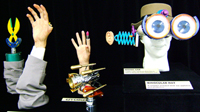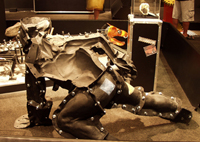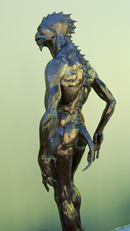Monsters are not part of my imaginative landscape, so I confess that I did not expect to enjoy this exhibition about the art and technology of animatronics. I thought it might be the sort of thing that people who love fantasy or horror movies would like, but that doesn't include me. Most of the films included in the exhibition I have never seen or even heard of, and I approached the gallery with a sense of duty rather than excited anticipation. The superhuman figure standing at the entrance and the roaring, growling noises from inside did little to change my mind. But by the time I reached the interactive dinosaurs, I was delighted to discover an exhibition, created by John Cox's Creature Workshop, that fascinated and intrigued me. Other visitors clearly shared my enthusiasm.

Not many people have heard of John Cox's Creature Workshop but millions have enjoyed the monsters, animals and special effects that he has created for movies such as Peter Pan, George of the Jungle 2, Inspector Gadget 2 and Babe, for which he won the 1995 Oscar for Visual Effects. This exhibition is a fascinating behind-the-scenes exploration of how animatronics work, based on material from the workshop of this remarkable Australian.
There are a number of reasons why the Australian Museum is presenting How to Make a Monster. The subject has broad popular appeal and is a good choice for the Christmas holidays. It was easy to see why families with children would enjoy this highly interactive experience, and the delighted cries and comments from young visitors as they manipulated the levers and pressed the buttons of the animatronics certainly added to my pleasure as I moved through the gallery.
John Cox has a long-standing link with the Australian Museum. He began his career in film by making props for television commercials (something he still does: the popular 'Bundy rum' polar bear is one of his creatures). At that time he made friends with George Hangay, the museum's Head Preparator. Liz Cowell describes in the November/December 2005 - January 2006 issue of the museum's magazine, Muse, how '[t]he two would exchange ideas about bone structure, movement and the skills needed to make animals look realistic. This understanding of real animals is still vital to his work' (p. 6).
One of the appealing features of the exhibition is the way it reveals the sources of inspiration for monsters. The introduction includes a very brief history of 'impossible beasts' including twelfth-century illustrations that were hybrids of real animals. These pictures were intended to fool the public into believing in the existence of monsters in nature.
As John Cox explains in Muse: 'We always research what already exists in real life - or what once existed - that could be close to the animal required' (p. 6). Display cases include birds, marine animals and reptiles from the museum's collection: oddities from nature that have inspired fantasy creatures such as mermaids and unicorns. Each of these creatures has features with a basis in reality, but the monsters are the result of unexpected combinations of wings or tails or beaks or claws, and the dramatic use of extraordinary colours and textures. These species intrigue and even terrify us because they appear at the same time natural and impossible.
What makes this exhibition so interesting is the way the secrets of special effects are revealed. There are many different techniques used by John Cox's Creature Workshop to deliver the illusion of reality on film, including mechanical and electronic devices, puppets, human actors inside animal costumes, and finally the editing and digital manipulation of images on screen. All of these techniques are explained through illustrations, text, objects and audiovisual programs that show how the special effects are created, including fragments of final footage from the films.

The first major section in the exhibition is a step-by-step explanation of the art and technique of animatronics. Original sketches and storyboards illustrate the way the artists establish the external appearance, the necessary internal structure and the working mechanisms of the creatures which are to be manipulated or worn by puppeteers or actors. It was already clear by this stage of my journey through the world of fantasy that there was a lot more to this business than I had expected. These animatronics are not just mechanical beasts operated by motors or electronics. They are closer to puppets and involve manipulation by human beings whose own movements lend life to the inanimate objects they operate.
The key sections of the exhibition introduce visitors to a range of characters incorporating various techniques. In some cases these techniques are also used by museums to bring their exhibits to life. Starlight, a unicorn, shows how taxidermy, a method that is very much at home in the museum context, is enhanced by a fan blowing the real horse's mane. As John Cox explains, it is these features - the real hair and the effect of the moving air - that make the difference between a dead model and a living creature.
Several creatures, such as the parrot from the 2003 Peter Pan movie, are exhibited in cutaway form to reveal their internal workings. The armature, painted skin and cable-controlled levers and joints that enable the claw of the parrot to be operated by the off-screen puppeteer were both complicated and intriguing. Nearby the cutaway head of a bear is displayed. In this case puppeteers control the creature's facial movements using remote-control devices.
The four gorillas from George of the Jungle 2 use very different techniques. They are revealed in an audiovisual program that accompanies and explains the costumes required to create the illusion of real animals. The layers of costumes worn by the remarkably fit performers include a cool suit with cold water running through it that the actor puts on first to enable him to avoid dehydration. Next he puts on the shape-changing muscle suit and finally the one-piece fur suit (each hair punched into the surface individually), together with the feet, head, and separate arms with hands attached. The acrobatics, stunts and dance routines performed by the actors on the film make it clear why the cool suit is an essential part of the costume!

Inside the main area of the gallery another, even taller, version of the creature from the entrance to the gallery stands still and silent, green and gaunt, part-man, part-reptile. This is the heroic figure of Gillman from the film Oceans of Fire. As Liz Cowell points out, 'the muscle tone and skin texture on Gillman highlight the anatomical detail required to make a monster lifelike' (p. 7). The same is true of the dinosaurs, crocodiles and komodos. They are not only lifelike but are also particularly effective interactive exhibits. Visitors can push buttons or, with considerable effort, operate levers to make different parts of the animal move. The fact that the mechanisms themselves are visible is fundamental to their appeal.
At just the stage in the exhibition when standing up becomes tiring, an excellent video is screening. It has subtitles for hearing-impaired people. Unlike some videos in exhibitions, this one captures and retains the visitor's attention. This is partly because John Cox is so witty and charming, partly because film is what this exhibition is all about, but also because people love to see behind the scenes and discover the inside story. The video explains not only the complex processes involved in making the animatronics, but also the physically demanding activities of the puppeteers who operate them.
Sequences from Babe explain the use of animatronic animals to guide the actions of live animals. Many of the sheep in Babe are real, but they did not always do what the camera required, so their animatronic companions were manipulated to lead the live sheep in the right direction. Another instance of this use of puppets with live animals occurred during the filming of a scene in Racing Stripes involving a zebra and a Clydesdale horse. The real animals didn't get on at all well together: the zebra kept biting the Clydesdale's knees and the Clydesdale nibbled the zebra's ears. So each of the real animals was paired with a well-behaved animatronic and filmed without painful distractions.

The design of How to Make a Monster is not elegant but it is appropriate for the subject. The battered crates used to transport the animatronics are the bases for the display bases. The drawings and models are working sketches and prototypes, not normally intended to be seen by the public, but in this context illuminating in their very roughness. The structure of the exhibition is logical and clear. The variety of exhibits, the level of interactivity and the workings of the special effects, including some of Inspector Gadget's gadgets, ensure that visitors are engaged and well-informed.
How to Make a Monster concludes with the reflection that there is ample evidence in the museum's collections of nature's monsters. When tiny bugs are seen in extreme close-up through SEM (scanning electron microscope) images, they provide a new way of looking at the gigantic fantasy creatures from film and fiction: impossible yet plausible and therefore horrifying.
A good exhibition makes you see the world differently and this one does just that. The objects from the Australian Museum's natural history collection that are displayed within the exhibition are newly fascinating because we view them through the lens of fantasy. It's as if we never looked at them before. This exhibition enables visitors to understand what goes into special effects on film, but it also invites us to look at the real world and find the monstrous in nature. Above all it encourages us to think about illusion and reality and our ongoing fascination with stories that we know are not true but which nevertheless delight us because we willingly suspend our disbelief.
Gabrielle Hyslop is the manager of Public Programs and Events at the National Museum of Australia and has 15 years' experience in cultural institutions.
